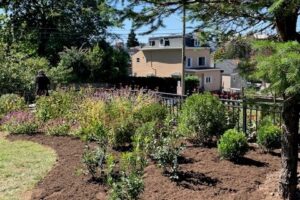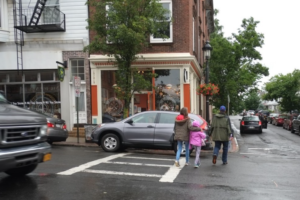After nine years of study and a taxpayer cost of $54,000,000 in consultant fees, the NYS Department of Transportation, after spending more than $147,000,000 for redecking the Tappan Zee Bridge, has reached into the past and decided to take down the 53-year old bridge and to construct a larger span with more traffic, far more noise, and deadlier air for Westchester and Rockland Counties.
 |
|
Option 1: Cars and trucks plus a bus lane and a pedestrian walkway. |
A Bus Rapid Transit system was selected as the preferred initial mass transit mode which will add exhausts to the already unhealthy air. This raises the crucial question, "Qui Bono? – Who Benefits?"
Labor unions, whose main concern is employment, can be expected to greet the new proposals with glee. But the citizens on both sides of the Hudson River and along the I-287 corridor will reap the toxic result which need not happen if the DOT is not deaf to the fact that Europe and Asia are building tunnels instead of bridges, because tunnels cost less to build and get completed faster. Public mistrust of government is at an all-time high. In addition, area residents probably will see the lack of wisdom in the DOT choice as they weigh the various impacts of such an expansion. Misappropriation and pork-barrel activity by special interest groups leave many citizens skeptical of entrusting any more hard-earned dollars to overdue infrastructure improvements without close and careful financial and engineering oversights.
Criticism abounds for the new, larger bridge package – one of seven studied options. The overall cost, now estimated to be $16 billion, will probably be in the $20 billion range, after additional design and construction costs and removal of the current TZB are included. This figure is almost one quarter of the entire projected NYS budget for 2008-2009! The problem of such spending becomes even more critical with the State and Federal governments so financially strapped. New York’s Chief Financial )fficer, Thomas DiNapoli, has already said that the State cannot afford to build a new bridge.
Westchester and Rockland residents need to be alert for findings on how the proposed new bridge will affect already out-of-compliance toxic ozone and particulate-matter levels, as well as the potential effects on rates of lung disease, cancer and sudden death along I-287. These effects are of greatest danger to our young children and the elderly.
The public seems united regarding the preservation of the beauty of our environment.
As often cited by The Riverkeeper, the effect of constructing a massive new TZB will inevitably lead to significant worsening of the Hudson River water quality. In contrast, a bored tunnel alternative would not.
For the longer term, creating a freight rail line in the mid-Hudson area would be a positive development. In recognition that growing levels of truck traffic are essential to our economy, negative air quality impacts can be greatly relieved by truck-on-train long-distance freight hauling.
The D.O.T. has offered that refurbishing the current bridge would cost almost 80% of a new bridge. That saving could go toward a tandem 2-tube, 7 mile long tunnel to create dedicated truck and mass-transit lanes. This would improve traffic flow and offer a strong safety feature on an auto-only, refurbished TZB. Modern tunnels offer the opportunity for scrubbing the air of toxic truck fumes and no longer require unsightly ventilation shafts. This mode was dashed, however, when the tunnel option was rejected in the 2004 Alternatives Analysis study. Its 11-point rejection was based on flawed and contested study comments which were never reopened for independent study as requested.
Based on new tunneling technology and on recent world costs for completed projects, a 7-mile long Tappan Zee Tunnel would cost a fraction of the D.O.T. chosen design, i.e., an estimated $2 billion vs. $6.4 billion for the planned new bridge superstructure. Another savings would be the difference in annual cost of tunnel maintenance, estimated at a fraction of the expected $5,000,000 million per year bridge maintenance costs.
Beyond cost, more due diligence and vigilance are needed on this vital project. As noted above, there are several areas where the D.O.T. needs to assure that the public’s vital interests will be protected, including independent studies of earlier important, contested findings. Questions repeatedly asked have been ignored. "Qui Bono?"
Concerned Citizens for Responsible Development
Sherwood Chorost, President, Westchester Branch
George Sherman, President, Rockland Branch






